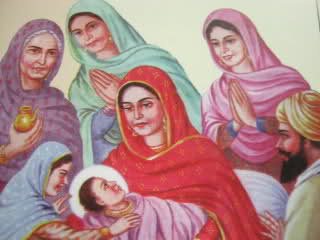
Mata Tripta Ji
The history of Sikh women has to start with Guru Nanak, the founder of the Sikh Religion.
According to the Bala Sakhis, Guru Nanak was very fond of his maternal grandmother. They were very close. Her name was Mata Bhirai, she was married to Rama of the village Chahal near Lahore.1 She was likely a frequent visitor to the home of Mata Banarasi, his paternal grandmother. In the prevalent custom of a joint family system, a woman always went to live in her husband’s family household, and because it was the custom for the grandparents to raise the children, one can assume that he would have been brought up by Mata Banarasi,2 his paternal grandmother. She was the mother of two sons, Kalu and Lalu, and wife of Shiv Ram, resident of Talvandi Rai Bhoi Ki, now called Nankana Sahib.
Much of what we know about the women of that era, has to be conjecture. One must look at what is known about socio-political, as well as the economic situation of the era, before one can even begin to guess what life must have been like for any given woman. The oral history or Janamsakhis give clues to events, but cannot be taken too seriously, in that they are coloured by the tellers’ own perception and background. As with any oral history, the story changes with time. Each story-teller tries to put his personal stamp on the story, as well as embellishment, so that it is always told better than the time it was told before. We do know that at that time in Hindu society, woman, at least in theory, controlled the family finances. In fact, they probably controlled only the portion of income that dealt with the personal household; i.e., the groceries and small household items. In a joint family system, even that would be limited to the “mother-in-law” and not to all the women. Also, it would be subject to the whims of the man of the house. Nevertheless, this was the situation at the time of the birth of the first Guru.
The mother of Guru Nanak was Mata Tripta.3 He was born on the third day of the month of Vaisakh, Saturday April 15, 1469.4 A midwife assisted Tripta on the occasion. Her name was Daulatan.5 MacAuliffe narrates in the tradition of the Janamsakhis that the midwife, when interrogated the following morning by Hardial, the astrologer, as to nature of the child’s voice uttered at birth, said it was “as the laughing voice of a wise man when joining a social circle.”
Mata Tripta was reputed to be a kind lady. The young Nanak had a sociable nature, and, therefore, had many friends. He liked to treat them often. We know from the oral history tradition that Mata Tripta would sometimes slip him a coin or two to spend on his friends. She also often made sweets for him to share with his friends. She loved her son dearly, but his rejection of tradition and custom was a source of constant aggravation. Her son, Nanak, questioned the authority of the Brahmin priests, refused to wear the holy thread, and rejected the validity of the caste system. Mata Tripta did not understand the divine mission of her rebellious son. This is clear in the story6 of Nanak’s return from his first travel. His parents met him at the edge of town. Nanak was overcome with emotion, and wept when he met his mother. She offered him sweets and asked him to remove the beggar’s gown and put on the clothes she brought him. She obviously worried about the friends and neighbours and what they would say, should they see him like this. On the same occasion his parents were much distressed. They believed that his travels and the rejection of present conventions were a sign of great unhappiness. His father, Kalu, was greatly disturbed when he exclaimed; “Only if I knew what has disappointed you in life, I would set things right. If you want to marry another woman, I’d get you one, if another house, I’d provide you with it.” This clearly was a generation gap. His parents, who were well-to-do and respected in their community, were greatly disturbed, because they did not understand why he would not conform to social customs of the day.